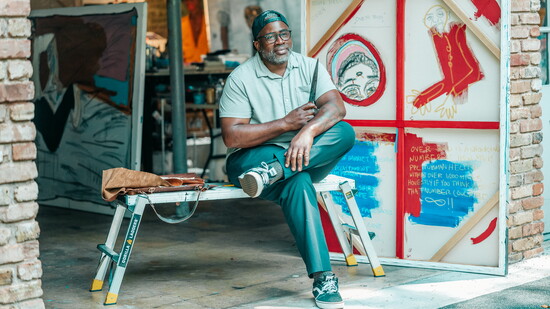Roscoe Hall is always cooking up something. For years, he plated dishes in kitchens that shaped American dining—from Alice Waters’ legendary Chez Panisse in California to Momofuku Ssam Bar in New York. “San Francisco was so expensive that I ended up homeless for a year, living in a flop house or crashing on a friend’s couch so I could shower,” Roscoe recalls. “I’d grab clothes out of my car for the week, show up for work clean-shaven with dreads, and no one knew what was up.” Today, you’ll find him in his Birmingham garage studio, grinding turmeric and collard greens into handmade pigments, painting at four in the morning before his kids wake.
His life could be told as a map of food and art, stitched together by chance, grit, and a certain punk-rock spirit. Roscoe grew up in Chicago, where his mother celebrated good grades by taking him out to dinner—sometimes a fine-dining room, sometimes a neighborhood spot—always with conversation at the table. She also took him to museums, where he got lost in Picasso sculptures and Van Gogh canvases before turning to skateboard graphics and album covers in the 1990s.
When he moved south, a legacy was already underway: his grandfather, John “Big Daddy” Bishop, had founded Dreamland Bar-B-Que in Tuscaloosa, where hickory smoke, ribs, and white bread became the stuff of legend. Watching his grandfather greet customers, his mother work the front, and his father prep for a Saturday rush helped shape the way Roscoe came to understand food and service. He soon stepped into jobs at Subway and odd Mediterranean grills, where he picked up the rhythm of kitchen work and the spark to keep moving forward.
In San Diego, while studying photography at the University of San Diego, he worked everywhere he could—from boardwalk burger joints to high-end La Jolla restaurants—“just to get a taste.” Next he headed to Chez Panisse, where California cuisine broadened his understanding: farmers’ markets, ingredients first, a style he calls “probably the most punk rock form of cooking” at the time. Graduate school at the Savannah College of Art and Design then put him in the middle of Savannah’s kitchens, where he cooked his way through town. “I was learning amazing Lowcountry cuisine, which made me learn so much more about the regional aspect to cooking,” he says. From there he moved to Portland, where new produce and methods reshaped his approach again. A stint at Momofuku Ssam Bar in New York followed, before Hurricane Sandy eventually sent him back home.
Back in Alabama, Roscoe became the culinary director at Rodney Scott’s Barbecue, where he wrote recipes and helped shape the expansion of the James Beard Award–winning restaurant. He cooked for private clients, directed food halls, and even had a turn on TV with Top Chef. When his son and daughter entered the scene, he was ready for a different pace of life. “I missed out on a lot of the first four years of my kids’ lives just because I was in a restaurant,” he remembers. So he redirected his creative passions, and painting became his primary pursuit.
In his studio, he still works like a chef—organizing tools mise en place, experimenting, testing, revising. With a grant from the state of Alabama, he began traveling the state’s eco-regions, turning crops into pigments. “Sweet potato pigment. Peanut ink. Collard greens—those are tricky, but I made it work. I wanted to tell a better story about where I live and where my family’s from,” Roscoe says. His quilt-inspired mural at Jones Valley Teaching Farm became one of his proudest projects: a nod to Alabama folk art that digs into its roots.
Food, of course, never left the picture. Roscoe is still the guy other chefs call. He develops recipes for Food & Wine, cooks private dinners, and keeps a Rolodex of flavors in his mind and in his self-illustrated recipe notebook. His wife, Emily, is a food stylist for People Inc., working across Food & Wine, People Magazine, Southern Living, Midwestern Living, Real Simple, and more. She’s also the creator of a Birmingham favorite: the Breakup Cookie. “She came up with it years ago after a breakup,” Roscoe laughs, “and now it’s in Piggly Wiggly and just about every gourmet shop in town.”
The Hall household is, unsurprisingly, a creative one—meals, pigments, ideas, kids running through. And when Roscoe isn’t painting or plating, he may be DJing old reggae records or exploring coffee shops the way some frequent bars. “You just have to believe in what you like,” Roscoe says. “It takes technique, sure, but once you get that, just focus. Have a good time, smile—maybe have a drink—and keep going.”
Roscoe Hall is a rare thing: a chef who paints, a painter who cooks, a Birmingham talent whose work belongs in both museums and kitchens. His path reminds us that art and food are both ways of telling a story, and that in the right hands, even Southern soil itself can become a masterpiece.
